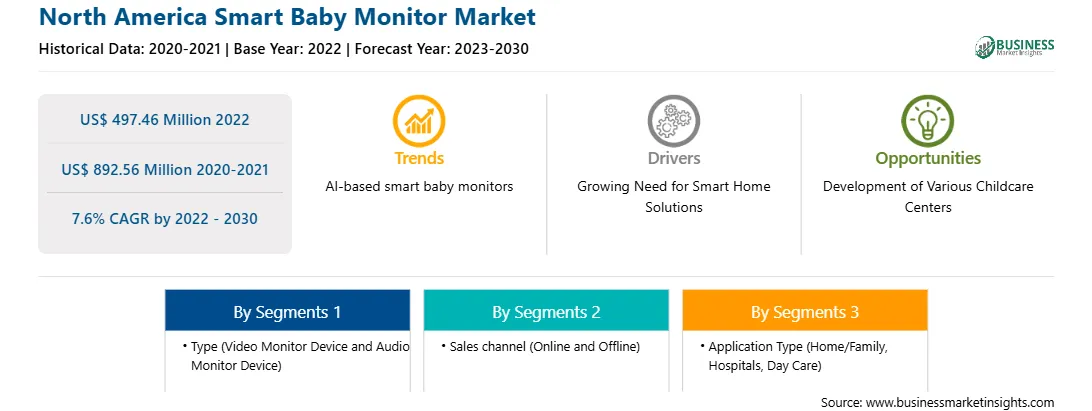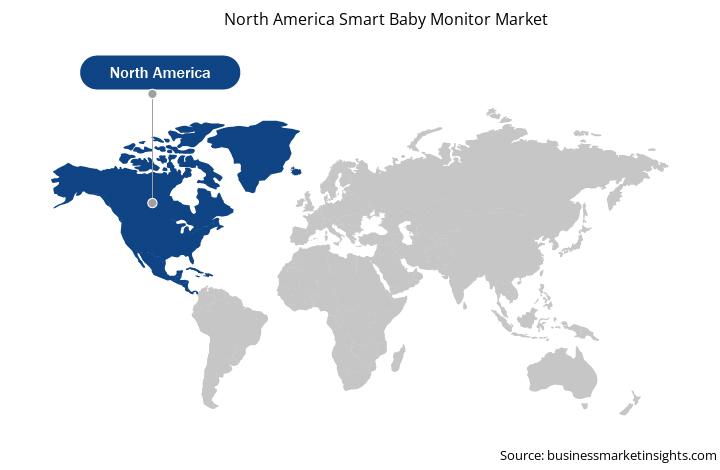The North America smart baby monitor market was valued at US$ 497.46 million in 2022 and is expected to reach US$ 892.56 million by 2030; it is estimated to grow at a CAGR of 7.6% from 2022 to 2030.
In the past few years, the trend of living in a nuclear family has been rising as it offers more financial stability than a joint family. Migration from villages to cities for education and jobs has been another prominent factor driving the rise in the number of nuclear families. Thus, to maintain the cost of living, both parents work, which is boosting the number of working parents across various countries such as the US, India, China, and Canada. Working parents are looking for nannies or day care facilities to take care of their kids when they are not home. The rising concerns correlated with child safety encourage them to purchase smart baby monitoring devices. Smart baby monitoring products assist parents in carrying out their activities effectively without being worried about their children's activities and safety. These systems assist in real-time communication among parents and their children through smartphones. With the rise in penetration of smartphones, parents are increasingly installing apps to monitor their babies.
Further, the rising purchasing power has resulted in increased spending on kids' safety. Hence, there is a constant expansion of online sales channels, as it offers consumers easy access to a variety of products. Thus, to cater to the demand for smart baby monitors among working parents, market players launched various solutions. For example, in April 2021, Miku launched the Miku Pro Smart Baby Monitor, which was developed to connect parents to their babies. The product's proprietary SensorFusion technology helps the parents to track breathing and sleeping patterns with no physical contact, which delivers enhanced safety for the baby. Thus, the increasing number of working parents drives the North America smart baby monitor market.
The US, Canada, and Mexico are among the key countries in North America. The US and Canada are among the region's most advanced countries as they are at the forefront of adopting technologies in almost all sectors. Moreover, the presence of significant smart baby monitoring system providers and the widespread awareness regarding these solutions further propel the market growth in North America. Moreover, there is high acceptance of smart baby monitors in the region as it is an early adopter of advanced technologies. These products allow parents to remotely track and monitor the movements of their babies.
A continuous contribution of companies and research organizations to technological advancements leads to healthy competition among various market players in the region. Moreover, the population in this region is more inclined toward technological developments due to high spending power. To address the growing consumer demands for high-quality products and services, companies in North America are continuously enhancing their overall business processes. Moreover, the availability of funding or ease of raising funds through joint ventures, partnerships, and other similar strategies is a key factor encouraging the smart baby monitoring market players to bring advancements in their monitoring system portfolios. For instance, in May 2020, Nanit, a maker of wearable baby sleep trackers and monitors, received funding of ~US$ 21 million after entering into a joint venture with Jerusalem Venture Partners (JVP), RRE Ventures, Upfront Ventures, and Rho Capital Partners.
A few of the well-known baby monitor market players present in North America are Dorel Industries Inc.; Angelcare Monitors Inc.; Summer Infant, Inc.; Samsung Electronics; Google Inc.; Koninklijke Philips N.V; and Nokia Corporation, among others.
Strategic insights for the North America Smart Baby Monitor provides data-driven analysis of the industry landscape, including current trends, key players, and regional nuances. These insights offer actionable recommendations, enabling readers to differentiate themselves from competitors by identifying untapped segments or developing unique value propositions. Leveraging data analytics, these insights help industry players anticipate the market shifts, whether investors, manufacturers, or other stakeholders. A future-oriented perspective is essential, helping stakeholders anticipate market shifts and position themselves for long-term success in this dynamic region. Ultimately, effective strategic insights empower readers to make informed decisions that drive profitability and achieve their business objectives within the market.

| Report Attribute | Details |
|---|---|
| Market size in 2022 | US$ 497.46 Million |
| Market Size by 2030 | US$ 892.56 Million |
| Global CAGR (2022 - 2030) | 7.6% |
| Historical Data | 2020-2021 |
| Forecast period | 2023-2030 |
| Segments Covered |
By Type
|
| Regions and Countries Covered | North America
|
| Market leaders and key company profiles |
The geographic scope of the North America Smart Baby Monitor refers to the specific areas in which a business operates and competes. Understanding local distinctions, such as diverse consumer preferences (e.g., demand for specific plug types or battery backup durations), varying economic conditions, and regulatory environments, is crucial for tailoring strategies to specific markets. Businesses can expand their reach by identifying underserved areas or adapting their offerings to meet local demands. A clear market focus allows for more effective resource allocation, targeted marketing campaigns, and better positioning against local competitors, ultimately driving growth in those targeted areas.

The North America smart baby monitor market is segmented based on type, sales channel, application, and country. Based on type, the North America smart baby monitor market is bifurcated into video monitor device and audio monitor device. The video monitor device segment held a larger market share in 2022.
In terms of sales channel, the North America smart baby monitor market is bifurcated into online services and offline services. The offline services held a larger market share in 2022.
By application, the North America smart baby monitor market is segmented into home/family, hospitals, and day care. The home/family held the largest market share in 2022.
Based on country, the North America smart baby monitor market is segmented into the US, Canada, and Mexico. The US dominated the North America smart baby monitor market share in 2022.
Vtech Holdings Ltd; Koninklijke Philips NV; Samsung Electronics Co Ltd; Panasonic Holdings Corp; iBaby Labs, Inc; INFANT OPTICS; Snuza; Dorel Industries Inc; NETGEAR; and Withings are some of the leading companies operating in the North America smart baby monitor market.
1. VTech Holdings Ltd
2. Koninklijke Philips NV
3. Samsung Electronics Co Ltd
4. Panasonic Holdings Corp
5. iBaby Labs, Inc
6. INFANT OPTICS
7. Snuza
8. Dorel Industries Inc
9. NETGEAR
10. Withings.
The North America Smart Baby Monitor Market is valued at US$ 497.46 Million in 2022, it is projected to reach US$ 892.56 Million by 2030.
As per our report North America Smart Baby Monitor Market, the market size is valued at US$ 497.46 Million in 2022, projecting it to reach US$ 892.56 Million by 2030. This translates to a CAGR of approximately 7.6% during the forecast period.
The North America Smart Baby Monitor Market report typically cover these key segments-
The historic period, base year, and forecast period can vary slightly depending on the specific market research report. However, for the North America Smart Baby Monitor Market report:
The North America Smart Baby Monitor Market is populated by several key players, each contributing to its growth and innovation. Some of the major players include:
The North America Smart Baby Monitor Market report is valuable for diverse stakeholders, including:
Essentially, anyone involved in or considering involvement in the North America Smart Baby Monitor Market value chain can benefit from the information contained in a comprehensive market report.